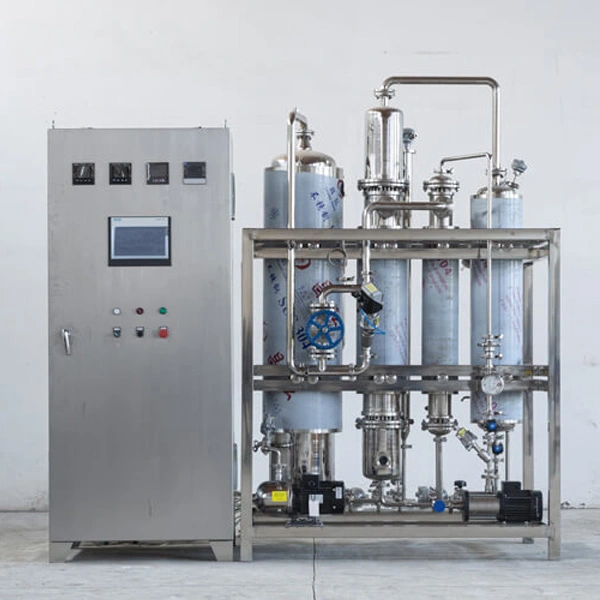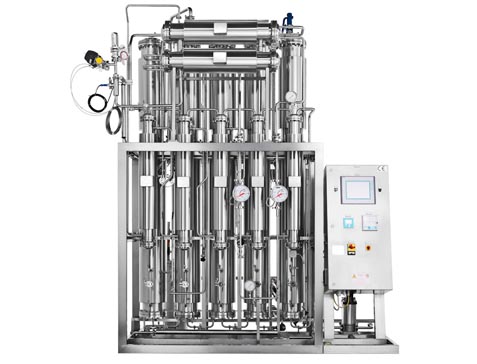Pure steam generator is one of the important equipment used in tank equipment, pipeline system and filter sterilization, and can also be used to drive the sterilizer. The quality of pure steam condensate prepared by Biocell pure steam generator meets the requirements for water for injection in the current USP, EP, JP and ChP, and also meets the relevant standards of EN285.
Pure steam generator is composed of evaporator, preheater, buffer tank, condenser, electrical appliances, instruments and pipelines.
Its working principle is: qualified raw water enters the branch condenser after being pressurized by the raw water pump, and then enters the separator and evaporator. The liquid level is controlled by the liquid level switch. The industrial steam enters the evaporator to heat the raw water to the evaporation temperature and form a strong thermal cycle in the evaporation chamber and separation chamber. After the raw water evaporates, the steam with water droplets will enter the separator, and the water droplets in the separator will be separated from the steam under the action of gravity and incorporated into the raw water. In addition, the unique steam water separation device on the upper part of the separator will generate ultra pure steam on the upper part of the separator.


Biocell's Pure Steam Generator stands out as a premier solution for industries demanding the highest standards of steam purity and reliability. Its advanced technology, robust construction, and compliance with stringent industry regulations ensure that it meets the critical needs of pharmaceutical, biotechnology, healthcare, and food and beverage sectors. With features designed for energy efficiency, safety, and ease of maintenance, this generator not only enhances operational efficiency but also supports sustainable practices. By choosing Biocell's Pure Steam Generator, facilities can achieve unparalleled performance and peace of mind, knowing they are equipped with a state-of-the-art system that delivers consistent, high-quality pure steam for their most vital processes.

Feedwater must be pumped into the generator, typically at 10 psig above the operating pressure. The flow is usually controlled by level.

Most pure steam generators use industrial steam heating, but for low capacity systems, electrical heating can be used.
The pressure of industrial steam must be higher than the required pure steam pressure, To provide a temperature difference for heat transfer. For economic reasons, the industrial steam pressure is usually at least 30 psi higher.

Sterilisation in pharmaceutical manufacturing is usually carried out at 121℃ (equivalent to 15 psig for saturated steam). Equipment and pipelines, where there is often no pressure control and achieving sterilization temperature is entirely dependent on the supply pressure of the pure steam.

The ability of a pure steam generator to remove contaminants depends on preventing droplets from being carried in the steam. Therefore, droplet removal is critical to the generator function.

The overcurrent part of most generators is made of AISI 316L stainless steel to avoid corrosion.

The concentrated water after continuous evaporation is regularly discharged from the bottom of the generator, including the liquid drops (bacterial endotoxin and pyrogen) removed by steam water separation. Usually, timed blowdown is used, which can also be triggered by conductivity measurement. The discharge of concentrated water is about 10% to 15% of the feed water.
As the pure steam system directly affects the purity of drugs, it is classified as a key system and needs to be verified. The typical activities of a validation process can be described sequentially as follows :
Design Qualification (DQ)
Installation Qualification (IQ)
Operational Qualification (OQ)
Performance Qualification (PQ)
The key requirement of the pure steam distribution system is to deliver pollution-free, dry and saturated steam to the point of use without overheating.
Invariably piping and other contact materials are AISI 316L stainless steel, to resist corrosion. To enhance the corrosion resistance of stainless steel itneeds to be passivated by a procedure such as that described in ASTM380.
In a pure steam system, condensate must be removed because it will cause water hammer and reduce the efficiency of pure steam. In addition, the condensate may cause microbial growth, which may lead to non-compliance with endotoxin specifications.
Removal of condensate relies on :
● Pipes sloped to direct the condensate to low points where steam traps
are used to remove the condensate from the system. Typically horizontal pipes are sloped with a minimum gradient of 1:100.
● Pipes must be properly supported to prevent sagging, steam traps should be placed at the bottom of vertical risers.
● The pure steam header is operated at low liquid level to allow condensate formed in the riser branch to drain back to the main header, which is itself a drain valve.
● Avoid dead corners where condensate may accumulate, for example, place the instrument branch pipe vertically upward.
● Good pipe insulation prevents excessive condensate formation.
Avoid mixing air into the pure steam system, The mixing of air and pure steam will reduce the effective temperature under the given pressure, leading to sterilization failure. In a pure steam system, air is usually discharged through a steam trap. In order to exhaust a large amount of air when starting sterilization, an exhaust port can be installed at the highest point of the distribution system.
When the pressure decreases, the steam becomes overheated, and the energy released by the high-temperature steam when the pressure decreases makes the steam higher than the saturation temperature. The presence of condensate reduces the tendency to overheat, and when steam attempts to evaporate condensate, it will return to saturation. In addition, the heat loss of the pipeline causes the steam temperature to drop, making the steam return to the saturated state again.
In actual operation, the pressure should not drop below 50% of the absolute supply pressure to prevent overheating (for example, if the steam supply pressure is 65 psia (50 psig), the pressure reduction should not be less than 33 psia (18 psig).
Pure steam systems are usually fabricated from sanitary tubing, using orbitally welded joints.
Special components of sanitary design, such as pressure reducers, instruments and relief valves, are available for use in pure steam systems.
There are normal operating/maintenance requirments for installing pressure and temperature instruments in pure steam systems, usually at or near the point of generation and at pressure reducing stations. Validation of the system may also demand that these are also placed at the end of long headers, or at other critical points.
Normal economic pipe sizing criteria apply, and often a maximum velocity criterion of 120 ft/sec is suitable. Pressure drops should be checked on very long distribution headers to ensure that superheat is not generated, and that the rquired delivery pressure at the point of use is maintained.
Phone:
E-mail:
Address:
Room 1904, Building 10, No. 218, Jiqingmen Street, Jianye District, Nanjing, Jiangsu, China


